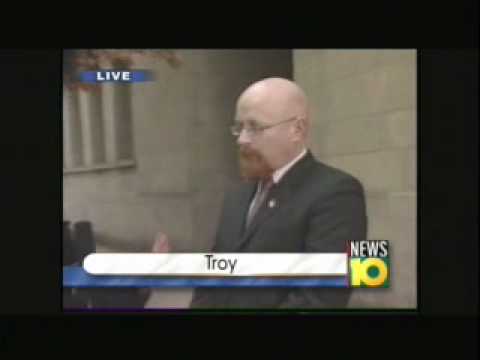There are allegations that Avery was framed by corrupt law enforcement officials. One of the most troubling elements of the case is the confession of Avery’s nephew, Brendan Dassey, who told police that he participated in the murder. Even though Dassey also went to prison, there are serious doubts about the veracity of his confession because he is developmentally disabled and may have been coerced into admitting to something he did not do. It remains to be seen if Avery or Dassey will be exonerated. But there are many documented cases of wrongful convictions which were secured by false confessions. A few years ago, we chronicled some of these stories. Here are 10 more examples of people who were wrongfully convicted because of a questionable confession.
10Gary Gauger
On the morning of April 8, 1993, an elderly couple named Morris and Ruth Gauger was found murdered at their farm in McHenry County, Illinois. The couple’s throats had been slashed. Their bodies were discovered by their 40-year-old son, Gary Gauger, who notified the authorities. Police began to suspect that Gary might have been the perpetrator and subjected him to an 18-hour interrogation. During this time, the investigators lied to Gauger about numerous things. For example, they told Gauger that he had failed a polygraph test and that incriminating evidence, including blood-soaked clothing and the murder weapon, was found in his bedroom. In the end, Gauger confessed to killing his parents. He was charged with the murders and sentenced to death, although his sentence was later commuted to life imprisonment. However, Gauger claimed that his so-called confession was not really a confession at all. During the interrogation, Gauger had become so exhausted that he began to believe he might have blacked out and committed the crime without remembering it. The cops supposedly asked Gauger to describe a hypothetical scenario in which he could have murdered his parents. When he complied, his hypothetical scenario was passed off as a confession. In March 1996, an Illinois appellate court determined that this so-called confession had been illegally obtained. Since there was no other evidence against Gauger, his conviction was overturned, and he was released from prison. One year later, James Schneider and Randall Miller, two members of the Outlaws motorcycle gang, were indicted for the murders of Morris and Ruth Gauger after Miller was secretly recorded admitting to the crime. Both men were sent to prison. Meanwhile, Gary Gauger received a full pardon for his wrongful conviction.
9Stefan Kiszko
On October 5, 1975, 11-year-old Lesley Molseed went missing after leaving her home in Rochdale, England. Three days later, her body was discovered on top of Rishworth Moor in nearby Ripponden. Molseed had been sexually assaulted and stabbed to death. Traces of semen were found on her clothing. The investigation soon focused on a 23-year-old tax clerk named Stefan Kiszko, who had been accused by other local teenage girls of exposing himself to them shortly before Molseed’s murder. Although those allegations turned out to be false, Kiszko was questioned by police. Months earlier, Kiszko had received testosterone injections because he suffered from hypogonadism. Police were convinced that this drove him to commit the crime. After being interrogated for two straight days, Kiszko finally confessed to Molseed’s murder on Christmas Eve. Eventually, he was convicted and sentenced to life imprisonment. However, Kiszko’s confession was called into question because he had a diminished mental capacity and his lengthy interrogation had taken place without the presence of his mother or a lawyer. Kiszko retracted his confession, claiming it was bullied out of him. The case was eventually reopened after it was discovered that key evidence supporting Kiszko’s innocence was not presented at his trial. An analysis of the semen sample found on Molseed’s clothing revealed the presence of sperm, but Kiszko was infertile and incapable of producing sperm. After serving 16 years for a crime he didn’t commit, Kiszko was released from prison in February 1992. Sadly, the ordeal had taken a severe mental and physical toll, and 41-year-old Kiszko died of a heart attack less than two years later. In 2007, DNA testing matched the semen sample to a sex offender named Ronald Castree, who subsequently received a life sentence for the murder.
8Adrian Thomas
In September 2008, 26-year-old Adrian Thomas rushed his four-month-old son, Matthew, to a hospital in Troy, New York, after the child became unresponsive. Matthew was pronounced brain-dead, and the doctor initially suspected a head injury. This compelled police to question Adrian about his son’s death. At first, Adrian denied doing anything wrong. But after being interrogated for 10 straight hours, he finally gave a videotaped confession in which he admitted throwing Matthew on a bed in frustration. Adrian was charged with second-degree murder. At trial, Adrian’s defense team maintained that his confession was coerced through a controversial method known as the Reid technique, which uses psychological manipulation to extract a confession from a suspect. During his interrogation, Adrian was falsely told that a confession could save Matthew’s life and that his wife would take the fall for the crime if he didn’t admit to it. Further medical examination found no evidence that Matthew had suffered a skull fracture. In fact, the doctor who initially reported a head injury came to believe that Matthew’s death was actually caused by sepsis, a blood infection. Nevertheless, Adrian’s videotaped confession proved strong enough to secure a guilty verdict and a sentence of 25 years to life. In 2012, Adrian’s case caught the attention of Blue Hadaegh and Grover Babcock, filmmakers who chronicled his story in Scenes of a Crime, a documentary about false confessions. Eventually, the case went to the New York Court of Appeals. They concluded that Adrian’s interrogation went too far and that his confession never should have been allowed in court. His conviction was overturned, and the confession was not presented as evidence at his second trial. Adrian Thomas was finally acquitted on June 12, 2014.
7Damon Thibodeaux
On July 19, 1996, 14-year-old Crystal Champagne went missing after leaving her apartment in Westwego, Louisiana. The following day, Champagne’s body was discovered 8 kilometers (5 mi) away. She had been strangled to death. Soon, the police set their sights on Champagne’s 21-year-old stepcousin, Damon Thibodeaux, who was visiting Champagne’s family at the time of the murder. When he was questioned, Thibodeaux allegedly failed a polygraph test. His interrogation lasted nine hours before he finally confessed to raping and murdering Champagne. Thibodeaux immediately recanted his confession. He claimed that he had simply told the police what they wanted to hear because he was exhausted and they had threatened him with the death penalty. However, the damage was already done. Thibodeaux was charged with killing his stepcousin and subsequently sentenced to death for first-degree murder and rape. Thibodeaux’s confession was in serious doubt because most of the details he provided did not match the crime. Although some of Champagne’s clothing had been removed, there was no physical evidence of sexual assault. In fact, there was no physical evidence linking Thibodeaux to the crime scene at all. In a surprise move, Paul Connick, the Jefferson Parish district attorney who put Thibodeaux away, eventually began to question the validity of his own conviction. He worked alongside Thibodeaux’s defense team to consult a forensic psychiatrist, who expressed his belief that Thibodeaux had made a false confession. Extensive testing was performed on all the crime scene evidence, and it uncovered no trace of Thibodeaux’s DNA. In September 2012, Thibodeaux’s conviction was vacated, and he was released from death row. As of early 2016, Crystal Champagne’s actual killer has yet to be found.
6Andrew Evans
On June 7, 1972, 14-year-old Judith Roberts left her home in the village of Wigginton, England, to go on a bicycle ride. Later that day, her battered body was discovered in a field. After an extensive investigation, the case took a bizarre turn that October when police were contacted by Andrew Evans, a 17-year-old soldier. He had recently been discharged from the nearby Whittington Barracks for health reasons and was taking medication for depression. Evans asked to see a photo of Roberts, claiming that he had dreamed about her and wanted to see her face. This compelled police to interrogate Evans for the next three days without the presence of a parent or counsel. Evans finally gave a signed confession admitting to Roberts’s murder. He was eventually sentenced to life imprisonment. However, Evans later retracted his confession. He claimed that he had made it while under the influence of Brietal, a so-called “truth drug” known for producing false memories. There was no other evidence tying Evans to the crime, and an unidentified fingerprint found on Roberts’s bicycle did not belong to him. Nevertheless, Evans was incarcerated for 25 years until his appeal was heard in 1997. Medical experts testified that his confession could have been the result of false memories and that he provided details about the crime which did not fit the actual evidence. The appeals court agreed that Evans’s confession was unreliable and overturned his conviction. Evans was released and awarded substantial compensation for his wrongful imprisonment. As of early 2016, the identity of the real murderer is still unknown.
5Christopher Ochoa And Richard Danziger
On October 24, 1988, a 20-year-old Pizza Hut employee named Nancy DePriest was raped and murdered during a robbery at her workplace in Austin, Texas. The investigation soon focused on Christopher Ochoa and Richard Danziger, employees from another Pizza Hut restaurant in the city. Both men were questioned separately. After several hours of interrogation, Ochoa finally confessed that he and Danziger had robbed the restaurant and raped DePriest. Although Ochoa claimed that Danziger was the one who actually shot DePriest, he agreed to plead guilty to murder and testify against his partner to avoid the death penalty. However, on the witness stand at Danziger’s trial, Ochoa surprised everyone by testifying that he was one who had pulled the trigger. As a result, Danziger was only convicted of rape. But both he and Ochoa received life sentences. In February 1998, the case took a surprising turn when Achim Josef Marino, a convict serving three life sentences for an unrelated crime, sent a letter to the office of Governor George W. Bush claiming that he was the sole perpetrator of Nancy DePriest’s murder. Marino had become a born-again Christian and wanted to clear Danziger and Ochoa of any involvement in his crime. To support his claims, Marino directed investigators toward his parents’ house, where he had hidden several pieces of evidence which implicated him, including DePriest’s keys. DNA testing was eventually performed on a semen sample. It matched Marino but excluded Ochoa and Danziger. The two wrongfully convicted men were exonerated and released from prison in 2001. Sadly, by this point, Danzinger was already suffering from severe brain damage after being attacked in prison 10 years earlier. He required constant care after his release.
4Darrel Parker
On December 14, 1955, Darrel Parker returned to his Lincoln, Nebraska, home and was horrified to discover that his wife, Nancy, had been bound, raped, and strangled to death. One week later, Parker was called in for questioning by the police. It escalated into a full-fledged interrogation which lasted several hours and ended with Parker confessing to his wife’s murder. Watch this video on YouTube He immediately attempted to recant his confession, but it was too late to prevent him from being charged with the crime. Even though there was no other evidence against Parker, he was convicted of murder and sentenced to life imprisonment. In 1969, an appeals court determined that Parker’s confession had been coerced and that his rights had been violated. Parker was paroled before he could receive a new trial. He built a new life for himself but still had to live with the stigma of being a convicted murderer. In 1988, Parker received an unexpected reprieve when death row inmate Wesley Peery died and a transcript containing numerous confessions was unsealed. After being sentenced to death for murdering a woman, Peery confessed to his attorneys in 1975 that he had committed several more murders. He claimed that one of those victims was Nancy Parker. Peery was a coworker of Darrel Parker at the time of the murder and had briefly been questioned by police. Peery ordered his attorneys to keep his new confessions sealed until after his death but provided so many specific details about the Parker murder that his confession was deemed to be credible. Darrel Parker eventually obtained a pardon for his conviction. In 2012, 57 years after the crime took place, he finally received a formal public apology and $500,000 in compensation.
3Darryl Beamish And John Button
In 1961, an 18-year-old, deaf-mute man named Darryl Beamish was convicted of brutally murdering Jillian Brewer in her apartment in Cottlesloe, Australia. Her nude body had been stabbed with a tomahawk and a pair of scissors. Beamish was interrogated by police and provided at least four confessions, two of which were given through a sign language interpreter. He was sentenced to death, but the sentence was later commuted. He was released after serving 15 years. In February 1963, a 19-year-old Perth man named John Button was charged with manslaughter after he confessed to running over his girlfriend, Rosemary Anderson, with his car. He was sentenced to 10 years in prison and paroled after serving five. Beamish and Button both maintained their innocence and claimed their confessions had been coerced by the police. Remarkably, these two seemingly unrelated crimes were both committed by the same man. The real perpetrator was Eric Edgar Cooke, who was nicknamed “The Night Caller” and considered to be one of the worst serial killers in Australia’s history. Cooke was responsible for at least eight murders and several more violent attacks. Ironically, while Button was serving his sentence at Fremantle Prison, Cooke was sent there to be executed. Before he was hanged in 1964, Cooke confessed that he was responsible for the deaths of Jillian Brewer and Rosemary Anderson. But the authorities never did anything with this information. Finally, in 2000, the Court of Criminal Appeal heard compelling evidence that Cooke was responsible for Anderson’s death and decided to quash Button’s conviction. Five years later, the court came to the same conclusion about Brewer’s murder and quashed Darryl Beamish’s conviction as well. Both men received compensation for their wrongful imprisonments.
2Eddie Joe Lloyd
On January 24, 1984, 16-year-old Michelle Jackson was raped and strangled to death in Detroit. Over the next several months, Eddie Joe Lloyd sent the Detroit police several letters about the Jackson murder and a Freedom of Information Act request for the case file. At the time, Lloyd was a paranoid schizophrenic who was confined to a psychiatric hospital and seeking treatment for mental illness. But investigators still found him suspicious. He was interrogated on multiple occasions until he finally admitted to killing Michelle Jackson. He provided a written confession and a recorded statement. The confession contained so many specific details about the crime that the jury deliberated for less than one hour before convicting Lloyd of first-degree murder. He was sentenced to life imprisonment. Unfortunately for Lloyd, his trial attorney proved so inadequate that he barely mounted a defense or questioned the validity of his client’s confession. Upon closer inspection, it became apparent that Lloyd’s confession had been coerced and that all the details he provided about the crime were fed to him by police. In fact, Lloyd claimed that he had agreed to make a false confession because the police told him it was nothing more than a ruse which would help bring the real killer into the open. Years after his conviction, Lloyd contacted the Innocence Project. They eventually performed DNA testing on several pieces of physical evidence from the case. In every instance, the testing excluded Lloyd as the perpetrator. On August 26, 2002, Lloyd finally had his conviction overturned and was released from prison. Unfortunately, he only enjoyed two years of freedom before he died. As of early 2016, the real perpetrator of the crime has not been found.
1Alstory Simon
In 1982, Anthony Porter was sentenced to death for the fatal shooting of Marilyn Green and Jerry Hillard, a young Chicago couple. Since Porter was mentally disabled, he was given a reprieve before his execution. David Protess, a journalism professor from Northwestern University, decided to take on the case. Protess’s investigation eventually focused on Alstory Simon, who was implicated in the murders by his estranged ex-wife. While being interrogated by Paul Ciolino, a private investigator employed by Protess, Simon confessed to shooting Green and Hillard in self-defense during an argument over drug money. As a result of Simon’s confession, Porter was released from death row and earned a full pardon. After pleading guilty to second-degree murder and involuntary manslaughter, Simon received a 37-year sentence. However, Simon later recanted his confession and made some shocking allegations. He claimed that Ciolino had impersonated a police officer while interrogating him and showed him a videotaped statement from an eyewitness who supposedly saw Simon commit the crime. In reality, this “eyewitness” was an actor hired by Protess and Ciolino to falsely implicate Simon. According to Simon, Protess and Ciolino manufactured false evidence against him to get Porter’s conviction overturned. They also colluded with Simon’s lawyer to pressure him into pleading guilty to avoid the death penalty. In addition, all the witnesses who implicated Simon in the crime, including his ex-wife, recanted their testimony and supported his allegations. In October 2014, Simon’s conviction was vacated, and the charges against him were dismissed. Simon has since filed a massive lawsuit over his wrongful conviction. The truth about who actually committed the murders remains murky. Robin Warder is a budding Canadian screenwriter who has used his encyclopedic movie knowledge to publish numerous articles at Cracked.com. He is also the co-owner of a pop culture website called The Back Row and recently wrote the award-winning script for a short film called Indefinite Late Fee. Feel free to contact him here.























